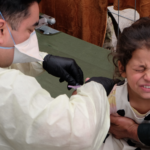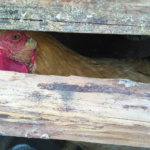Lessons from the Netherlands
By Laura H. Kahn | January 10, 2011
With more than 4,000 people falling ill since 2007, the Netherlands is experiencing one of the world’s worst outbreaks of Q fever. A zoonotic disease (meaning it can be transmitted from animals to people), Q fever can cause sickness and even death in humans. The Dutch struggle to address the ongoing outbreak can be instructive in terms of how to improve the handling of public health crises, and the rest of the world would do well to learn from their experience.
Political leaders need to use their best judgment and common sense when developing response policies; connecting experts in the human, animal, and environmental health communities would help tremendously.
Background. Despite its small size, the Netherlands is home to some of the world’s largest dairy goat farms, with a total of more than 350,000 goats. Concentrated mainly in the Noord-Brabant province in the country’s southern region, these goat farms have an average of about 600 animals. The farms are located close to one another and often border villages and cities. When densely packed animals live near densely packed people, the conditions are ripe for diseases to spread. And one did: Q fever.
Q fever is caused by the bacterium Coxiella burnetii, which was first discovered in 1935 in slaughterhouse workers in Australia. Today, it can be found all over the world (except for New Zealand). The “Q” stands for “query” because for years no one knew what caused the disease, and by the time the microbe was discovered in 1937, the name had stuck.
Goats, sheep, and cattle are the primary animals infected by C. burnetii, and ticks can transmit Q fever. The bacteria are excreted in the milk, urine, and feces of infected animals, and are present in extremely high concentrations in the placentas and amniotic fluids of infected animals — indeed, researchers have found up to 1 billion organisms per gram of aborted placenta. People can fall sick after inhaling contaminated barnyard dust, according to the Centers for Disease Control and Prevention (CDC).
C. burnetii is extremely infectious; a single microbe can cause disease. Like anthrax, it can form spores that humans can inhale and is resistant to drying and disinfectants. These qualities make the bacterium quite durable. The bacteria can also be aerosolized, and the CDC characterizes C. burnetii as a possible bioweapons agent that is “a potential terrorist threat.” (The United States developed Q fever as a biological weapon in the 1950s but halted its program in 1969 when President Richard Nixon renounced the use of offensive biological weapons. Addressing Q fever remains an important issue for the US military; cases of the disease have been reported among military personnel serving in virtually all US wars since the microbe was discovered.)
Infected farm animals typically do not show signs of Q fever, but the illness does cause them to have stillbirths or to abort. In humans, around 60 percent of people do not get sick from exposure to C. burnetii, but for the 40 percent who do, the initial flu-like symptoms can progress to atypical pneumonia or hepatitis. Pregnant women can deliver prematurely or spontaneously abort. For 1 percent to 5 percent of the people who fall sick, Q fever can become a chronic, debilitating disease that can progress to life-threatening endocarditis (infection of the heart lining). At least 13 people have died from Q fever in the Netherlands since the beginning of the outbreak.
The outbreak. In 2005, waves of spontaneous abortions began occurring in animals on dairy goat farms (and on one dairy sheep farm) in the province of Noord-Brabant. As many as 60 percent of the farms’ pregnant animals aborted, primarily in the final month of pregnancy. The animals had not appeared sick, and the full-term offspring had high rates of mortality. Treatment with antibiotics did not prevent further abortions, which continued to occur throughout 2007.
Q fever was identified as the culprit; however, at the time the Dutch government did not require Q fever cases to be reported to either agriculture or health authorities. As a result, nothing was done to prevent further outbreaks.
In the spring of 2007, the weather had been unusually dry and hot, and the disease made its way from the livestock to the human population. Near one village in Noord-Brabant, doctors reported clusters of people with atypical pneumonia along with some cases of severe pneumonia unresponsive to standard antibiotics. That year, a total of 168 human cases of Q fever were reported in the Netherlands.
Unfortunately, the disease continued to spread. By 2008, people began getting sick in Nijmegen, a city about 15 kilometers from the 2007 outbreak. Here, a small flock of sheep had the illness; apparently, some of the people who became sick had cuddled some of the lambs. Another wave of spontaneous abortions struck a large number of dairy goats on a farm close to Nijmegen. The farmer never showed any symptoms of the disease, but his wife suffered from fever and coughing; laboratory tests confirmed that both were infected with Q fever.
In 2008, 1,000 people in the Netherlands were reported to have Q fever: of these, 545 had pneumonia, 115 had febrile illness, and 33 had hepatitis. In 2009, the number of reported cases of Q fever shot up to 2,357 people; of these, 459 patients required hospitalization, and six died.
Most of the people who contracted the illness — around 60 percent — lived within 5 kilometers of a farm with infected dairy goats or sheep.
The government response. In June 2008, the Dutch government made Q fever a “notifiable” disease for dairy goats and sheep, which meant that farmers had to report to government officials if their animals tested positive. Four months later, the Dutch Ministry of Agriculture implemented a voluntary goat vaccination program, marking the first time that a Q fever vaccine was used on goats to prevent the disease in humans.
Yet the number of human infections increased. In early 2009, the Dutch government implemented more stringent measures, including a mandatory nationwide hygiene protocol for dairy goat and sheep farms. The protocol introduced special measures for handling animal manure, controlling vermin, preventing dust and aerosol formation, and compulsory processing of placentas and aborted fetuses. Vaccination became mandatory for all dairy goats and sheep in the entire province of Noord-Brabant and in smaller neighboring areas.
As the public became increasingly aware of the health crisis, the Dutch government moved to take extreme preventive measures and decided to slaughter all pregnant animals on farms where Q fever was present. The culling began in December 2009 and continued through June 2010. More than 50,000 dairy goats were killed in an effort to contain the disease.
Despite this drastic step, the Q fever outbreak in the Netherlands continues. From January to October 2010 (the most recent numbers available), 482 more human cases were reported, including seven deaths.
The investigation. The Dutch government launched an investigation assessing its response to the crisis and in late November 2010 published its findings. The full report is available only in Dutch, severely limiting its usefulness to the global community; however, an English translation of the report’s summary has been made available.
Among the findings of the committee tasked with the investigation was that the government’s overall response to the Q fever crisis was slow and uncoordinated, hampered by disagreements in attitude and policy between the Ministry of Agriculture and the Ministry of Health.
The Ministry of Agriculture had initially denied the role of dairy goat farms in causing human Q fever cases because of a lack of scientific proof of causality; the Ministry of Health, in contrast, considered the clustering of human cases around dairy goat farms with high abortion rates as sufficient proof. When epidemiologic evidence showed that human Q fever infection rates were inversely proportional to distance from dairy goat farms with abortions, the Ministry of Agriculture changed its mind.
The committee also found that the outbreak response was hindered by concerns about commercial confidentiality: The exact locations of infected farms were initially unknown to public health researchers, seriously impeding research on what was causing the infections until the Dutch government made Q fever a notifiable disease. In addition, the government did not call the agriculture industry to account for its responsibility in the crisis. The investigation concluded that the government was too slow in communicating with the public, resulting in anxiety among the Dutch population.
Implications and improvements for the future. From the public health perspective, the Q fever outbreak in the Netherlands is extremely important and warrants the close attention and scrutiny of the global community. Livestock agriculture has become increasingly intensive and concentrated. Hundreds, sometimes thousands, of animals are kept in close quarters, increasing the risks for disease emergence.
As the global human population increases to a projected 9 billion people by 2050, the demand for animals and animal products will increase. Producing affordable meat and dairy products will require economies of scale — hence the need for intensive agriculture, like the Dutch dairy goat farms.
In other epidemics involving livestock zoonotic disease, such as avian influenza in Asia and bovine spongiform encephalopathy in the United Kingdom, the governments of the involved countries — specifically, their departments of agriculture — have protected the agriculture industry, since that is part of their mandate. Governmental health departments usually don’t enter the picture until a public health crisis develops, but by then the damage has already been done — the Dutch experience has been no different.
Do the interests of agriculture necessarily supersede the interests of public health? Although to most people the answer would be “no,” during the initial stages of zoonotic disease epidemics involving livestock, the government’s answer is typically (and unfortunately) “yes.” Yet there is a much better way to approach zoonotic disease crises.
In recognition of the links between human, animal, and environmental health, a global “One Health” movement (which I support and participate in) has been growing based on the concept of increasing communication and collaboration between these sectors.
The vast majority of emerging infectious diseases (HIV/AIDS, avian influenza, West Nile virus) are zoonotic, as are most bioterrorism agents (anthrax, Q fever, plague, tularemia). Zoonotic diseases are clearly the common link between public health and biodefense; therefore, it behooves us to combine public health and biodefense efforts. The challenges of implementing a unified approach are considerable, since barriers between the medical, veterinary, public health, agriculture, and environmental health communities have been growing for decades.
Science does not always have all the answers — a fact that the Dutch report summary acknowledges. I’ve written about the challenges that government officials face when confronted with disease outbreaks in which experts either are stumped or have conflicting opinions. In such circumstances, political leaders need to use their best judgment and common sense when developing response policies; connecting experts in the human, animal, and environmental health communities would help tremendously.
Building these bridges will require leadership, financial incentives, joint educational programs, shared conferences, and other efforts that introduce an interdisciplinary way of thinking. The Dutch response to the Q fever crisis not only shows that new steps must be taken to better protect public health, but also demonstrates how important an integrated approach, like One Health, will be in the future.
Together, we make the world safer.
The Bulletin elevates expert voices above the noise. But as an independent nonprofit organization, our operations depend on the support of readers like you. Help us continue to deliver quality journalism that holds leaders accountable. Your support of our work at any level is important. In return, we promise our coverage will be understandable, influential, vigilant, solution-oriented, and fair-minded. Together we can make a difference.
Topics: Biosecurity, Columnists















